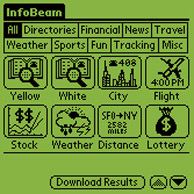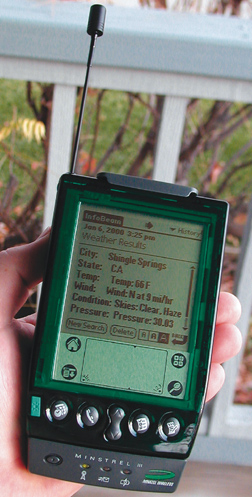JP Systems
Three apps help make your Palm wireless
Chances are, if you've been doing any wireless activity with your Palm, yet you don't own a Palm VII, you're using a program by JP Systems. More programs are coming out that compete with them, but JP Systems has been at the forefront of bringing wireless communication to the Palm platform for some time. You'll just as often see their products integrated by solution providers, such as we've seen most recently with OmniSky.
BeamLink
One of the first wireless solutions for the Palm was BeamLink. BeamLink allowed owners of the Connected Organizer to make it even more connected, by allowing infrared communication between a Palm and a two-way pager. Most two-way pagers are great for reading email pages, but have very clumsy input methods, allowing only short messages to be returned, like "Yes," or "I'll be right there." BeamLink smartly optimized these pagers, taking advantage of the Palm's easier Graffiti input method, its ability to store more data, and its ability to communicate via IrDA. Merging a Palm with a wireless two-way pager effectively gave the Palm a wirelessly-accessed, wireless modem with pager to boot, making both the pager and the Palm that much more useful.
BeamLink works much like their newer One-Touch Mail program, which is logical, since BeamLink acts as an email program. It will quickly sync with the pager when you press the Send and Receive button, grabbing all the messages from the pager, and sending any that are waiting in the queue. You can also edit and compose what are called "Canned Messages." The Glenayre pager I've been using has a few of its own, but you can use many more to make your canned messages more personal or pertinent when you send and receive from the Palm. It would be ideal if you could sync some of these canned messages to the pager, that way you wouldn't need to use the Palm at all in a hurry.
As I customized the canned messages on the Palm at Comdex, I was better able to respond to my associates who were peppering me with messages from their RIM pagers. RIM pagers are faster, but the BeamLink solution is less expensive, and only with BeamLink can you attach vCards and text files straight out of your Palm's four major applications.
To get even more sophisticated, there's the Text-to-Voice feature, which will allow you to simply type your message, enter a phone number to call, and the service will callthe number and read the email to the recipient. Very nice. BeamLink can be purchased separately or with a pager. By itself, it's US$49.95, and with the Glenayre AccessLink II pager it's US$269.95. Pager plans start at US$24.95, with a $20 setup fee.
InfoBeam
Working with even more devices is the popular InfoBeam program. It can use the pager and Palm combo mentioned above, or it can be used with a Novatel Minstrel III modem and a Palm, and even the Motorola PageWriter 2000 (not compatible with the Palm). And when they say Info, they mean Info. This thing has built-in links to the InfoBeam information server, giving you access to stock quotes, weather reports, lottery results, flight information, directory services, FedEx and UPS tracking, directions, restaurants, and it'll even calculate the distance between two points for you so you can plan your drive.
I played with InfoBeam on a few different platforms, and it was about as useful as my Palm VII for many things; and in many cases it was better than some PQA's just for its ease of use. It seemed to work equally well regardless of the platform, though it was clearly faster on the Minstrel III than the pager, since the pager had to send and receive its query on a considerably slower system. The longest wait I had using the AccessLink pager was about two minutes for a weather forecast, most everything else was available in seconds. Just like a Palm VII, it has a history file that is available with a single tap, allowing you to review information you've already downloaded. Anything that saves me time and bits is appreciated. InfoBeam is thoughtfully designed, and simple in just the right ways. It is available for free download, but you must sign up for the InfoBeam service, available at www.infobeam.com.
One Touch Mail
As I've mentioned, One Touch Mail is a lot like BeamLink. Thankfully the two programs can coexist as well. But whereas BeamLink deals with only one account-the pager account-One Touch Mail can handle up to six email accounts. It works with a landline modem as well as a Novatel Minstrel.
Setting the program up for each server is pretty easy. For each server, you just enter the simple information for SMTP and for POP3. The only confusing part is when you switch to the second server POP3 remains selected, so you enter that information, but when you go back to enter the SMTP info, it goes back to the first server and its information. If you're attentive, it's no big deal, but the problem could have been avoided by putting the server numbers before the address types, and making them dependent on the server number, rather than vise versa.
When composing an email, you can access email addresses from the Palm Address Book application. Unlike the iMessenger application on the Palm VII, if your contact listing has more than one email address listing, One Touch Mail will show all of them. That's a great feature. If you're mailing notes to groups of people a lot, you can use the Address Book to create a small distribution list. Just open a new contact, enter the name you want for the list, and enter up to five email addresses by changing the names of all the fields to "E-Mail." The latter is important, because One Touch will only recognize them as email addresses if you select that as the type for each field.
I did run into a peculiarity with the address listing: when you've sorted your Address Book by company name first, the addresses that appear in One Touch will appear hopelessly jumbled, since it doesn't endeavor to re-sort them by last name for you. When I went and resorted my Address Book by last name, it worked fine. Oddly, BeamLink does not have this problem, displaying part of the company name and part of the last name. This is a problem for me, because I must have the Address Book sorted by Company, since I can't remember all the names associated to each company, especially with over 600 entries. I was unable to find a dialog box that would allow me to select display of the company name first.
The main screen makes sending email very simple. The program starts up with the email list screen, or folder screen. From here you can quickly view messages in the inbox, select them for deletion, search for specific emails by their attributes, and select which attributes you want to view (subject, date, sender, file size), and send and receive. They've done a lot to make this simple screen meet most of your needs with one touch. Also on this screen is an icon where you can switch to the email address view. Most other Palm email programs require you to go through multiple steps before you can enter an address, but One Touch allows you to start with-yes-one touch. Well, actually two: you have to select address view first, then tap on the name you want, and you'll have a screen that has the cursor in place on the first line, flashing patiently waiting for you to enter the first character of your email. From here you can select additional addresses for Blind Copy, add attachments from one of the four main Palm apps, and even use canned messages with a few simple taps.
You can choose from three buttons for sending and receiving: Send, Receive, or Send and Receive. Clicking on Send and Receive when there's nothing to send gives the message that "There are no messages in the outbox." I thought that was cute, but it's actually a good thing, letting you know that you may have stored the message you intended to send in the draft box or else you accidentally deleted it. Clicking on Receive brings up a dialog that allows you to select a server to receive from, and also allows you to download the full messages, or just the headers. If you get a lot of email and are a frequent target of junkmail pitches, this can save you time and money when you're in a hotel room far away from home. Once you have the headers, you can download only the ones you want. Something missing from some older email applications, One Touch only downloads new email messages, instead of downloading the ones you left on the server all over again.
Messages that have Palm attachments from another Palm user will have a special icon associated with them, called a "double note" (it looks like a box overlapping a box). Clicking on these icons allows you to move the attachment, say an Address Book entry, to the Address Book on your Palm. It's surprisingly useful, serving as a sort of long-distance beam.

Deleting or moving messages is quite easy. There's a small dash next to each email listing. Clicking on the dash turns it into a check mark. From there, you can use the first pulldown menu to delete or move the item. Email can also be automatically sorted into different categories upon arrival, or after retrieval for storage.
Printing of retrieved messages is also supported, though you need printing software from Steven's Creek Software and an IrDA-enabled printer.
As with all of JP Systems' software, One Touch Mail is thoughtfully designed, with both convenience and power in mind. The program doesn't try to do too much, and it doesn't download email from the desktop during HotSync, nor does it send any to the desktop. It's a no-nonsense email application with some excellent features. It is available from their website for US$49.95.
JP Systems has designed their applications for both individual users or for business users. For businesses, they will customize their applications to work with different types of hardware, as well as to meet specific needs for the varying requirements of business users. All three products are worth a serious look if you need to add wireless functions to your Palm computer. www.jpsystems.com -
-Shawn Barnett
|



